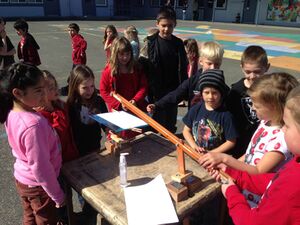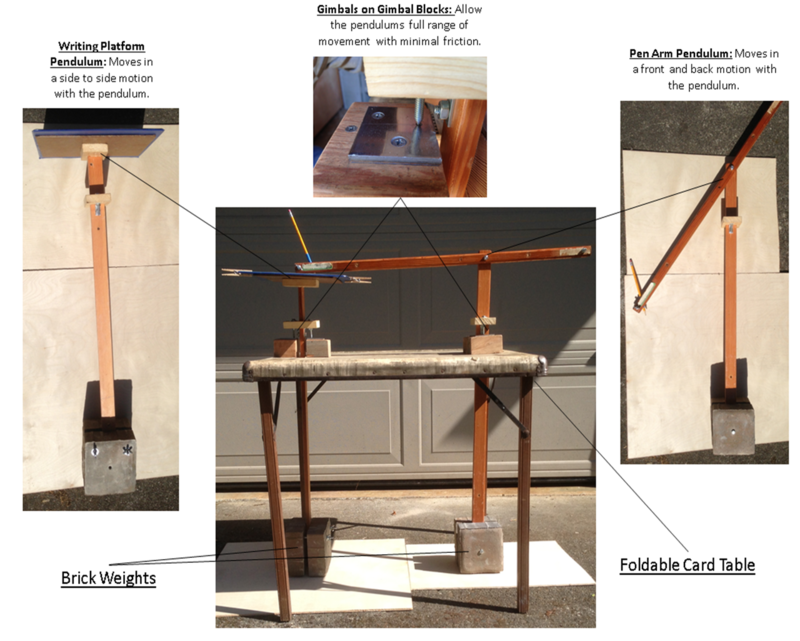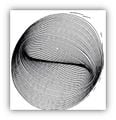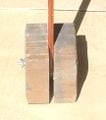
The Two Pendulum Harmonograph was created by Team C.R.A.M (Creative Reuse Art Machine) in the ENGR215 Introduction to Design class at Cal Poly Humboldtto fulfill the need of SCRAP Humboldt to have a an art machine made out of upcycled materials that they can take to schools and art festivals to demonstrate creative reuse. Other options were considered as a final solution to SCRAP Humboldt's problem, but the Two Pendulum Harmonograph was found to be teh best solution to the problem presented by SCRAP Humboldt. The project underwent many changes to become an art machine that visually demonstrates the interaction between two pendulum frequencies.
Background[edit | edit source]
Engr 215 Introduction to Design, a class offered by Cal Poly Humboldt, is an Engineering Design class. Every semester, the class designs specific products for a client to educate students and give them experience in working in group projects with clients. Spring semester, 2013, the design class worked with SCRAP Humboldt. Scrap Humboldt is a non-profit organization the aims to inspire creativity and sustainable behaviors for all ages, through creative reuse of materials from the waste stream.
Problem statement and criteria[edit | edit source]
Our mission was to create an art machine for SCRAP Humboldt to take to schools, festivals and other events to inspire creative reuse by being fun and interesting for people of all ages.
Specifications:
- Fits in a 1998 Volkswagen Beetle.
- Made out of 75% or more reused material.
- Able to be carried by 1-2 people.
Considerations:
- Will be used by adults and children.
- Needs to be easy to setup and transport.
- Must complement SCRAP Humboldt's existing paint spinner.
Criteria is weighted 1 to 10, 10 being the highest.
| Project Criteria | Description | Weight |
|---|---|---|
| Safety | Safe for both adults and children | 10 |
| Engaging | Visually stimulating | 9 |
| Repairability | Easy to repair | 8 |
| Durability | Ability to withstand daily use by both adults and children | 7 |
| Unique Design | Ability to create more than 2 different unique designs | 7 |
| Ease of Use | Easy to use | 6 |
| Portability | Ability to fit in a 1998 Volkswagen Beetle and can be carried by 1 or 2 people | 5 |
| Cost | Cost less than $300 | 4 |
Description of final project[edit | edit source]
Based on our criteria, a two pendulum harmonograph was the ideal solution. A harmonograph is a machine that uses pendulums to create parabolic curves, or Lissajous figures. The harmonograph has two pendulums that swing perpendicularly with a pen and paper attached. As pendulums swing, they swing at fixed frequencies. The pen and paper track the combination of the two frequencies and create a drawing. The drawings show the harmony between the two pendulums. Below is a diagram of the final solution with labeled parts.

Below are samples of the many possible designs. The main variation in these drawings is the ratio of the pendulum's frequencies. By moving one of the weights higher or lower, results in the change of frequency. The images produced when the pendulums are in harmony, tend to be more visually pleasing. On the other hand, when the pendulums are in disharmony, the images tend to look more chaotic.
- Images
-
-
-
-
-
-
-
-
Costs[edit | edit source]
Materials cost with retail price and actual project cost.
| Material | Use | Quantity | Retail Cost ($) | Retail Cost Total ($) | Project Cost ($) |
|---|---|---|---|---|---|
| 48" x 1/4" x 1 1/2" Wood | Pendulum Arms | 4 | 2.50 | 10.00 | 0.00 |
| Table | Frame | 1 | 25.00 | 25.00 | 0.00 |
| Brackets | Gimbal Brackets | 4 | 0.75 | 3.00 | 0.00 |
| 4" x 1/2" x 2 1/2" Wood | Gimbal Blocks | 4 | 0.50 | 2.00 | 0.00 |
| Bricks | Pendulum Weight | 4 | 0.50 | 2.00 | 2.00 |
| 3 1/2" Bolts | Secures Writing Instruments | 2 | 0.59 | 1.77 | 1.77 |
| 6" Bolts | Secure Weights | 6 | 0.79 | 4.74 | 4.74 |
| Wing Nuts | Secure Weights | 6 | 0.30 | 1.80 | 1.80 |
| Bolt Nuts | Secure Weights | 10 | 0.10 | 1.00 | 1.00 |
| 1 1/2" Bolts | Pen Arm Fulcrum | 2 | 0.94 | 1.88 | 1.88 |
| 3 1/2" Bolts | Gimbal | 4 | 0.86 | 3.44 | 3.44 |
| Wood Screws | Reinforcement | 16 | 0.03 | 0.48 | 0.48 |
| Plywood Board | Writing Surface | 2 | 7.50 | 15.00 | 0.00 |
| Binder | Writing Surface | 1 | 7.00 | 7.00 | 0.00 |
| Total Cost | $79.11 | $17.11 | |||
Maintenance cost[edit | edit source]
To ensure proper function of the machine, minor maintenance must be done. First, the pen and paper must be replaced after use, and the joints where the pen arm connects to the pendulum must be lubricated as needed.
The machine is comprised mainly of wood products and must be stored in a dry area to mitigate mold and warping. Finally, the surface underneath the paper may become rough from use, so it may need replacement if this occurs, though this is unlikely.
The table below assumes SCRAP Humboldt will have donated art supplies such as paper and pens available.
| Maintenance Task | Frequency | Cost/Year ($) |
|---|---|---|
| Replace Pen | When Ink Dries | 0.00 |
| Replace Paper | After Every Drawing | 0.00 |
| Lubricant | When Needed | 5.00 |
| Total Cost | $5.00 | |
Testing Results[edit | edit source]
Team C.R.A.M. built and tested the Two Pendulum Harmonograph. Results of testing showed that users were able to set up the machine in under five minutes and was easily transportable, being able to fit in trunks of a 1998 Volkswagen Beetle. The drawings that machine made, showed that machine was able to create a large selection of unique designs.
Further testing was done at a local elementary school where durability of the machine, safety of young children and how interested children where in the machine were tested. The children showed interest by clamoring to get a look at the machine. Experts of child behavior and development saw no danger in the harmonograph. The machine was able to withstand use by children and after testing was done, the machine was unscathed by the continuous use by children.
How to assemble[edit | edit source]
The first step in using the harmonograph is to assemble the machine. Start by unfolding the card table and putting it on a flat stable surface. The next step is to take the pendulums and insert them through the slots in the table. The pen arm pendulum goes in the slot that orients the pen right above the other slot. This other slot is for the paper platform. If you put the pendulums in the wrong slots the pen arm will be pointed the wrong direction.
The final step is to attach the weights to the pendulums. The paper platform weight clamps down on the pendulum with two bolts cinched together by wing nuts. This clamping mechanism allows for quick weight height adjustments. The pen arm weight has a long bolt that must be fed through a hole in the pendulum. This weight is not meant to be adjusted.
- To insure the gimbal is properly aligned, the pointed bolts must go into the depression on the gimbal stand which keeps the pendulums from shifting around.
-
1. Unfold card table
-
2. Put pendulums in the the table slots
-
3. Place rounding bolt in depression
-
4. Clamp weight around paper platform pendulum
-
5. put bolt through weights and pendulum
How to use[edit | edit source]
Normal operation of the harmonograph is quite simple. Once the pen and paper are secured to their respective pendulums, all you have to do is set the pendulums into motion by rocking them back and forth and drop the pen arm. To get different drawings from the machine there are a couple different parameters that you can change. First is the position of the weight. Moving the weight up and down will alter the frequency of the pendulum and therefore the harmonic ratio between the two. Next, the period can be altered by starting the pendulums at different positions in their swing. The final way to alter the drawing is to alter the amplitude of the pendulums. This can be achieved by putting more or less energy into the pendulum's swing.
-
1. Place writing utensil
-
2. Set weight
-
3. Set counterweight on pen arm
-
4. Set pendulums in motion
-
5. Drop pen arm
Informational video which highlights the project and how to use it.
Discussion and next steps[edit | edit source]
Weight adjustments
- The weights are not as easy to adjust.
Improved pen arm design
- The pen arm is a very sensitive part of the machine. The current design has a little too much friction built into it. As a result it has to be loosened and there is a little side to side play. A better design could be made.
Gimbal design
- The gimbal design exceeded expectations in performance. There is very little friction in that part of the pendulum.
Pendulum height
- From testing, result show that a two-pendulum harmonograph would work a little better with longer pendulums. Because of the project's size constraints, the design turned out a little small. With longer pendulums the drawings would be larger, the pendulums would swing for a longer time and it would be easier to fine-tune the pendulum length to get different desired harmonic ratios. However, the height for the design worked well for the machine, as it allows children to access it easily.
Authors[edit | edit source]
Update October 2014[edit | edit source]
Actually, the two-Pendulum Harmonograph is still in the SCRAP Humboldt. According to interview with the staffs, the project is used during events with the society to show a creative use of ucpycled materials. The frequency of use is at least 4 times per year. The equipment is well maintained and working very well; it is easily storable and does not occupy much space. It is possible to assemble without much difficulty. However, the paper platform pendulum is more complicated to clamp the weight than the pen platform. During the motion, the paper platform touches the floor, causing friction and making the pendulum stop.
-
Front View of two-pendulum harmonograph
-
Detail
-
Detail pen arm while working
-
Brick Weights






















